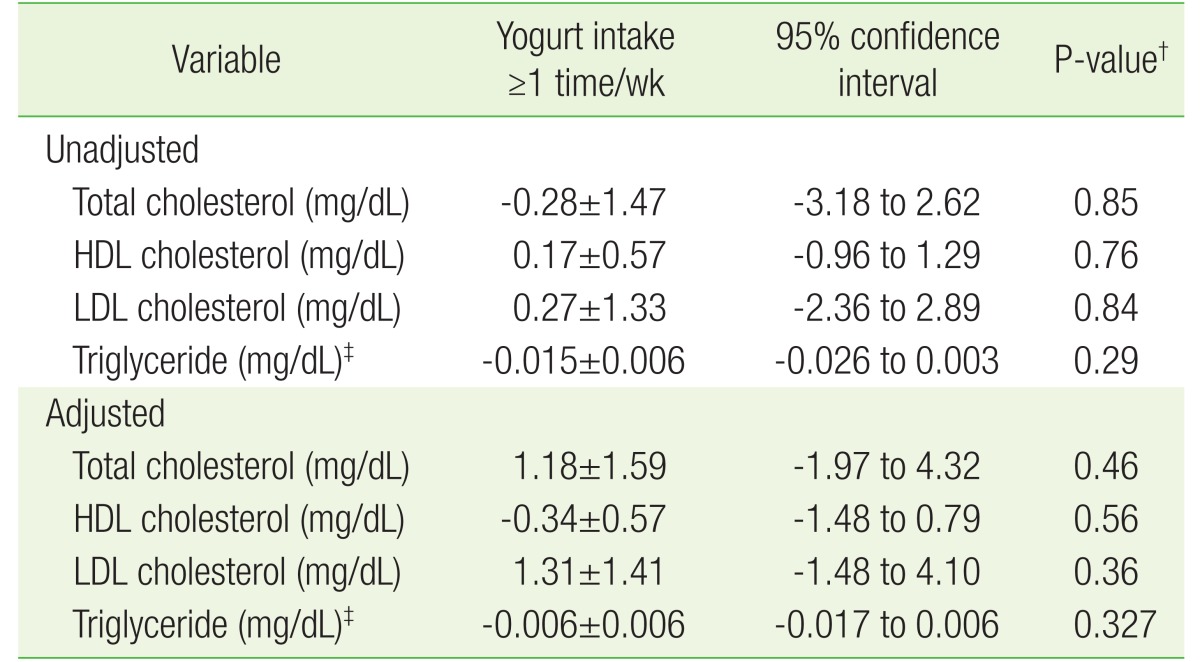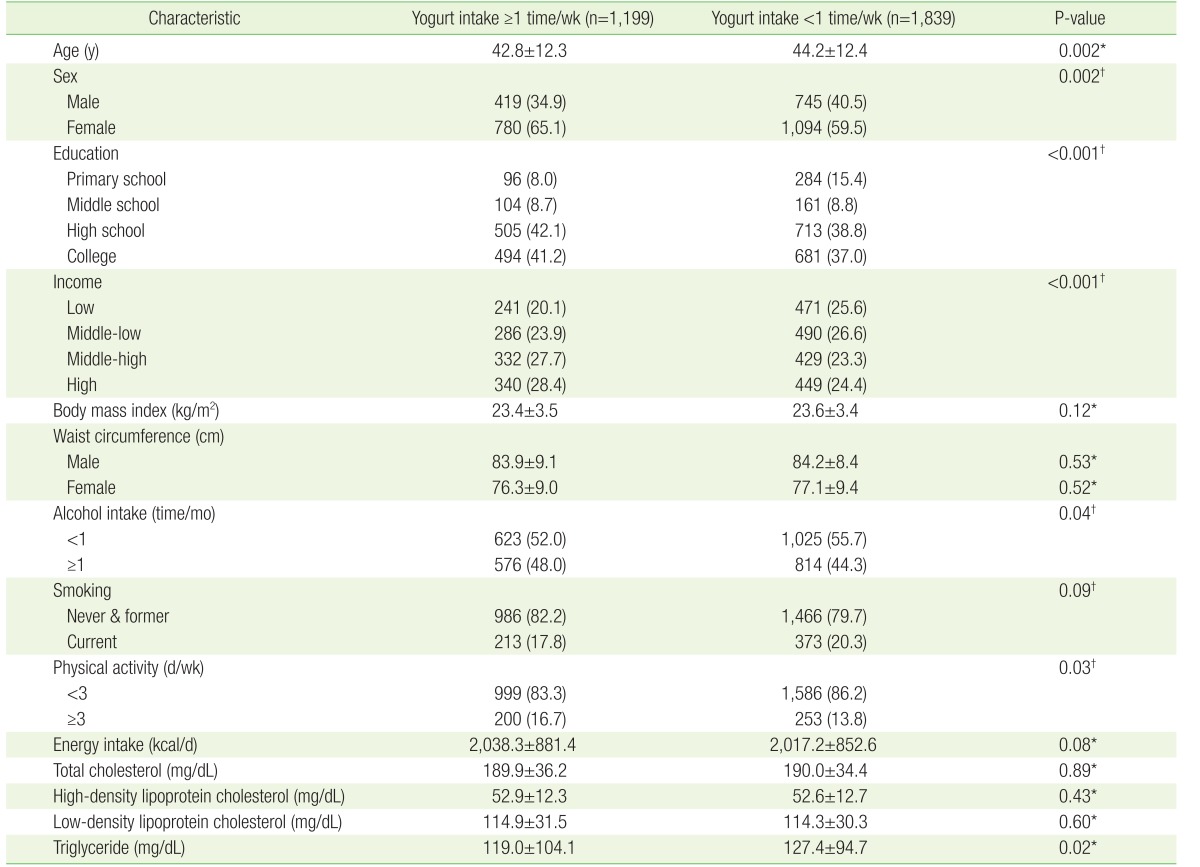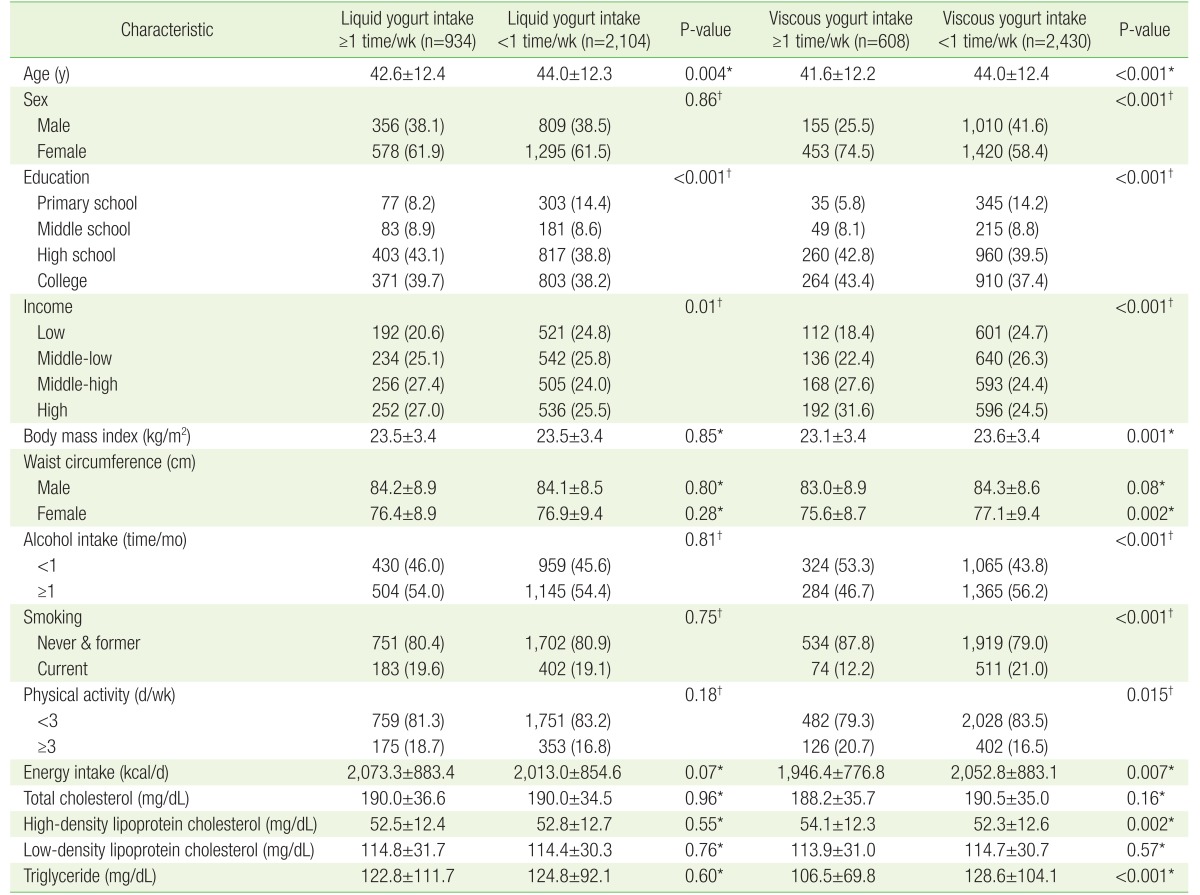Serum Lipid Levels in Relation to Consumption of Yogurt: The 2012 Korea National Health and Nutrition Examination Survey
Article information
Abstract
Background
The purpose of this study was to evaluate serum lipid levels in Korean adults after consumption of different types of yogurt.
Methods
Study subjects were 3,038 individuals (≥19 years of age) who participated in the 2012 Korean National Health and Nutrition Examination Survey. Yogurt intake was assessed with a food frequency questionnaire by using the 24-hour recall method. We conducted complex samples general linear analysis with adjustment for covariates.
Results
The serum triglyceride levels in the group consuming viscous yogurt were lower than those in the group consuming non-viscous yogurt.
Conclusion
Consumption of viscous yogurt is associated with low serum triglyceride levels in Korean adults.
INTRODUCTION
Hypertriglyceridemia as a risk factor for cardiovascular disease is becoming important in the context of the growing epidemic of metabolic syndrome and obesity, and high triglyceride levels are known to play an important role as a marker associated with atherogenic lipoproteins.1) Evidence suggests that triglyceride levels more than 150 mg/dL are an independent risk factor for cardiovascular disease as a component of metabolic syndrome.2) In Korea, mortality from cardiovascular disease and cerebrovascular disease has ranked second and third, respectively, among causes of death.3) Ischemic heart disease or cerebrovascular disease is caused by plaque disruption and atherosclerosis, which are closely related to increased fasting plasma triglycerides, high levels of low-density lipoprotein (LDL) cholesterol, and low levels of high-density lipoprotein (HDL) cholesterol.4) Therefore, the importance of managing dyslipidemia is highlighted by many guidelines. The National Cholesterol Education Program-Adult Treatment Panel III guidelines recommend lifestyle changes including dietary modification, exercise, and weight reduction for management of dyslipidemia.5)
Among these recommendations, dietary modification is a powerful nonpharmacological strategy for the treatment of dyslipidemia. For example, dietary fiber has been shown to favorably alter blood cholesterol levels, while omega-3 fatty acids lower blood triglyceride levels.5) There have been some studies that have examined the effect of dairy intake on dyslipidemia, obesity, and metabolic syndrome.6) In studies on the association between dairy intake and obesity, dairy intake was found to have a protective effect against obesity.78) In a Korean study, regular consumption of milk resulted in lower rates of metabolic syndrome, obesity, abdominal obesity, hypertriglyceridemia, hypertension, and impaired fasting glucose compared with a control group.9) Yogurt is a food produced by the fermentation of milk, and there has been increased interest recently in the effect of probiotics in yogurt to improve cholesterol metabolism, with several studies currently in progress internationally.10)
The aim of the present study was to examine the correlation between consumption of different types of yogurt and serum lipid levels in Korean adults. As per our knowledge, there has been no evaluation of serum lipid levels in relation to consumption of different types of yogurt. Numerous previous studies have revealed that dairy products and probiotics have a positive effect on serum lipid levels. However, none of these studies has addressed the difference between liquid and viscous yogurt. Moreover, we believed that the amount and type of lactic acid bacteria could have an effect on serum lipid levels. We also assumed that, depending on the consistency of each type of yogurt, the amount and type of lactic acid bacteria might differ.
METHODS
1. Study Subjects
The study used data from the 2012 Korean National Health and Nutrition Examination Survey (KNHANES). A total of 6,293 participants aged 19 years or over were selected; among these, 3,255 were excluded because of insufficient information regarding education, income, body mass index, waist circumference, alcohol intake, smoking, physical activity, daily energy intake, or serum lipid levels. Participants were also excluded if they did not respond to the food questionnaire, did not observe the 8-hour fasting period, were undergoing treatment for dyslipidemia, or were pregnant. Ultimately, a total of 3,038 participants were included as study subjects.
2. Yogurt Consumption
In the 3,038 study participants included, yogurt consumption was assessed with a questionnaire on food frequency by using the 24-hour recall method. As few participants consumed yogurt more than two times per week, we classified participants into two groups: those with yogurt consumption ≥once per week and those with yogurt consumption <once per week. In the statistical analyses, frequency of yogurt intake was calculated as the average frequency.
3. Other Variables
Data regarding age, sex, education, income, smoking, alcohol consumption, and physical activity were obtained using a self-report questionnaire. Level of education was categorized into four groups: elementary school graduate or below, middle school graduate, high school graduate, and college graduate or higher; level of income was categorized as low, middle-low, middle-high, or high; and smoking status was classified as current or non-current smoker. Current alcohol consumption was classified as <1 time per month or ≥1 time per month; frequency of physical activity was classified as <3 days per week or ≥3 days per week.
Body mass index was calculated using the formula body weight (kg)/height (m2). Waist circumference was measured to one decimal point at the end of a normal expiration by using a tape measure at a level midway between the lowest rib and the iliac crest, without pressing into the skin.
Blood samples were obtained from all participants. As LDL cholesterol was undisclosed for individuals whose triglyceride levels were below 200 mg/dL in the original data, LDL cholesterol was calculated using the Friedewald formula. Log-transformation of triglyceride values was performed to account for the extreme right skewness of the data.
4. Statistical Analysis
Statistical analyses were conducted using the complex samples procedure because the KNHANES data set was selected using a representative, stratified, and clustered sampling method, not a random sampling method. The t-test was used for continuous variables, such as age, body mass index, waist circumference, daily energy intake, and serum lipid levels, while the chi-square test was used for categorical variables, such as sex, level of education, income, smoking, alcohol consumption, and physical activity. Two groups of participants were created according to consumption of yogurt (Table 1): the yogurt-consuming group and non-consuming group were defined on the basis of yogurt consumption ≥1 time per week and <1 time per week, respectively. Two groups of participants were additionally created in relation to consumption of different types of yogurt (liquid or viscous), with all 3,038 participants accounted for in the two groups (Table 2); these were further divided into subgroups according to frequency of consumption (<1 time per week or ≥1 time per week). General linear analysis of complex samples was used to evaluate serum lipid levels depending on consumption of yogurt irrespective of its type, and type of yogurt consumed after adjustment for confounding factors such as age, sex, level of education, income, smoking, alcohol consumption, physical activity, and daily energy intake. Data were analyzed using IBM SPSS Windows ver. 20.0 (IBM Corp., Armonk, NY, USA). P-values <0.05 were considered significant.
RESULTS
1. General Characteristics of the Study Participants
The general characteristics of the group consuming any kind of yogurt more than once a week and the group consuming any kind of yogurt less than once a week are shown in Table 1. The general characteristics of the participants according to type of yogurt consumed are shown in Table 2. Among the 3,038 participants, 1,199 participants consumed any kind of yogurt more than once a week. The following characteristics were observed for these participants: younger age, higher educational status, higher income, less alcohol intake, less physical activity, a greater proportion of women, and lower triglyceride levels than the participants who consumed any kind of yogurt less than once a week (P<0.05) (Table 1). Among the 3,038 participants, 934 individuals consumed liquid yogurt at least once a week and 608 consumed viscous yogurt at least once a week (Table 2). Regardless of the type of yogurt consumed, the subgroups with yogurt intake ≥1 time per week had a younger average age, higher level of education, and higher income than the subgroups consuming yogurt <1 time per week (P<0.05 for both) (Table 2).
With regard to consumption of viscous yogurt, in the subgroup with higher weekly intake, women outnumbered men, body mass index was lower, waist circumference was smaller in women, alcohol consumption was lower, smoking was less frequent, physical activity was greater, daily energy intake was lower, and serum triglyceride and HDL cholesterol levels were lower than those in the subgroup with intake <1 time per week (P<0.05).
2. Serum Lipid Levels in Relation to Consumption of Different Types of Yogurt: General Linear Analysis of Complex Samples
General linear analysis of complex samples was used to evaluate serum lipid levels according to consumption of yogurt (Table 3) and consumption of different types of yogurt (Table 4), after adjustment for confounding factors such as age, sex, level of education, income, smoking, alcohol consumption, physical activity, and daily energy intake. Triglyceride levels among participants consuming viscous yogurt ≥1 time per week were lower than the levels among those consuming viscous yogurt <1 time per week (P<0.05) (Table 4). Neither levels of total cholesterol nor levels of HDL and LDL cholesterol were correlated with yogurt consumption.

Serum lipid levels of the study participants consuming yogurt ≥1 time per week compared with <1 time per week*
DISCUSSION
The results of the present study showed that serum triglyceride levels were significantly lower in participants who consumed viscous yogurt ≥1 time per week than in those consuming viscous yogurt <1 time per week. No significant triglyceride-lowering effect was observed in participants who consumed liquid yogurt ≥1 time per week compared to those consuming liquid yogurt <1 time per week. There was also no significant triglyceride-lowering effect in participants who consumed any kind of yogurt ≥1 time per week compared to those consuming any kind of yogurt <1 time per week.
Hypertriglyceridemia is a prevalent risk factor for cardiovascular disease and is increasingly important in the context of the current epidemics of obesity and insulin resistance. High triglyceride levels are markers for several types of atherogenic lipoproteins.1112) Treatment of hypertriglyceridemia is based on lifestyle modification and the administration of medications, such as statins, fibrate, niacin, and omega-3 fatty acids.13) There are also some foods known to have an effect on lowering blood triglyceride levels.141516) Yogurt, a dairy product with some unique properties owing to its specific manufacturing process, is known to significantly lower the risk of metabolic syndrome, including obesity, and also to reduce the risk of cardiovascular disease.14151617) Commercially available yogurts are divided into fermented milk and concentrated fermented milk depending on the numbers of lactic acid bacteria and contents of milk solids-not-fat (MSNF). Fermented milk is standardized to contain at least 10 million lactic acid bacteria per milliliter and more than 3% of MSNF. Concentrated fermented milk is standardized to contain at least 100 million lactic acid bacteria per milliliter and more than 8% of MSNF.18) In addition, viscous and liquid yogurt can be categorized depending on the physical properties of each type of yogurt. Therefore, in the current study, we defined each yogurt according to these categories. Viscous yogurt used in our study belongs to the category of concentrated fermented milk, with both >8% of MSNF and more than 100 million lactic acid bacteria. In contrast, liquid yogurt used in our study includes fermented milk with >3% of MSNF and more than 10 million lactic acid bacteria, as well as drinkable types of concentrated fermented milk. Therefore, individuals in the group consuming viscous yogurt might have consumed more lactic acid bacteria and MSNF than those in the group consuming liquid yogurt.
Different levels or types of probiotics and MSNF in either viscous yogurt or liquid yogurt may distinguish the degree of lowering of blood triglyceride levels. The MSNF contain the lactose, caseins, whey proteins, and minerals (ash content) of the product from which they were derived.19) It is thought that higher calcium intake facilitates lipolysis and lipid oxidation through its effects on intracellular calcium concentrations.2021) Several intervention studies have reported that calcium intake has a beneficial effect on lipid profiles.2021) A study has reported that calcium ingested through yogurt diminished postprandial lipid response followed by a decrease in the postprandial increase in chylomicron triacylglycerol.22) Milk-derived bioactive peptides exert several other important health-promoting activities, besides their anti-hypertensive effect, including involvement in the regulation of insulinemia, modulation of the lipid profile, and stimulation of the satiety response, all of which may play roles in the prevention and treatment of metabolic syndrome and its complications.23)
In terms of probiotics, recent studies have focused on the use of these substances to improve cholesterol metabolism. For example, levels of total cholesterol, LDL cholesterol, and triglycerides decreased by 2.7%, 3.2%, and 5.2%, respectively, in 32 adult men who consumed 100 mL of low-fat yogurt containing Bifidobacterium longum three times a day for 4 weeks,24) and total cholesterol and LDL cholesterol decreased by 12.1% and 19.7%, respectively, in 20 adults who consumed a capsule containing 2×109 Enterococcus faecium M74 once a day for 56 weeks.25) However, the mechanism by which serum triglyceride levels reduce is not fully understood. In one study, administration of probiotics to rats led to transcriptional changes in peroxisome proliferator-activated receptor-α, carnitine palmitoyltransferase II, sterol regulatory element-binding protein-1, fatty acid synthase, and stearoyl-CoA desaturase-1; it was assumed that these changes were responsible for the reduction in serum triglyceride levels.26)
Probiotics settle in the gut and increase the production of short chain fatty acids (SCFAs) following the fermentation of indigestible carbohydrates from food, and finally SCFAs produced in the gut enter the liver.27) SCFAs might inhibit the synthesis of fatty acids in the liver, thereby decreasing the triacylglycerol secretion rate and serum triglyceride levels.28) Viscous yogurt has higher content of MSNF and probiotics within it than liquid yogurt, which can contribute to lowering blood triglyceride levels.
Our study has several limitations to be considered. First, we classified the groups according to the number of times each participant consumed yogurt, but we could not determine the quantities of yogurt consumed. Second, this study was not a prospective cohort study; therefore, it is difficult to establish a direct effect of yogurt consumption on serum lipid levels. Third, as this study was based on 24-hour dietary recall, the type and amount of food intake might have been inaccurate. Although lifestyle variables, such as alcohol intake, smoking, total energy intake, and physical activity, have been adjusted in this study, these variables might have not been sufficiently adjusted if the differences among these variables were too great. Lastly, the study did not show any precise difference between consumption of liquid yogurt and viscous yogurt.
Despite these limitations, and in conclusion, our study has shown for the first time that consumption of viscous yogurt is associated with low serum triglyceride levels. Further studies should focus on determining which probiotics or which specific ingredient affects serum cholesterol levels, and how they act.
Notes
CONFLICT OF INTEREST: No potential conflict of interest relevant to this article was reported.


